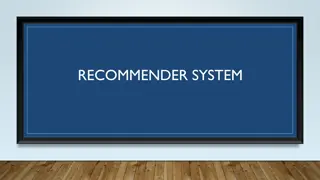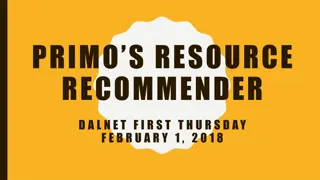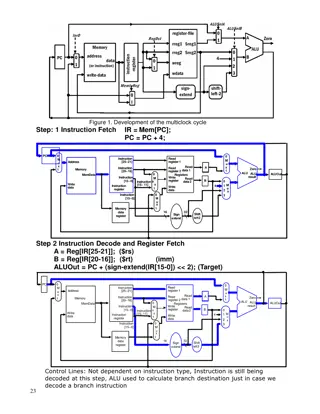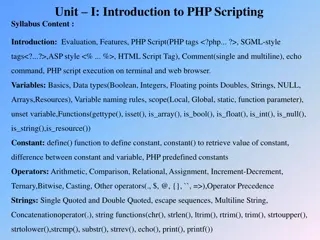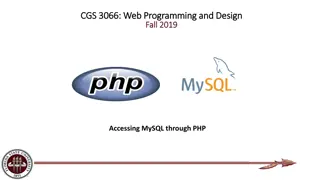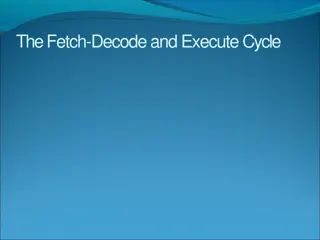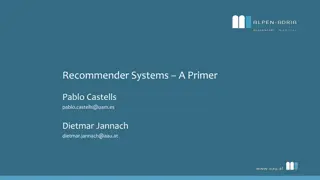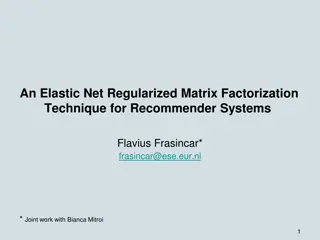
Advanced Techniques in Recommender Systems
Explore the world of recommender systems with a focus on collaborative filtering, memory-based approaches, model-based techniques like clustering and matrix factorization, and more. Understand the challenges and solutions in predicting user preferences, handling sparse data, and generating personalized recommendations. Dive into topics such as content-based, context-based recommendations, and the importance of diversity and socialization in recommendation systems.
Download Presentation

Please find below an Image/Link to download the presentation.
The content on the website is provided AS IS for your information and personal use only. It may not be sold, licensed, or shared on other websites without obtaining consent from the author. If you encounter any issues during the download, it is possible that the publisher has removed the file from their server.
You are allowed to download the files provided on this website for personal or commercial use, subject to the condition that they are used lawfully. All files are the property of their respective owners.
The content on the website is provided AS IS for your information and personal use only. It may not be sold, licensed, or shared on other websites without obtaining consent from the author.
E N D
Presentation Transcript
Recommender System Wenkai Mo
The Recommender Problem Estimate a utility function to predict how a user will like an item.
Outline Collaborative Filtering Content-based Recommendations Context-based Recommendations Ranking Diversity Socialization
Outline Collaborative Filtering Content-based Recommendations Context-based Recommendations Ranking Diversity Socialization
Collaborative Filtering The task of predicting (filtering) user preferences on new items by collecting taste information from many users (collaborative). Challenges: Many items to choose from Very few recommendations to propose Few data per user No data for new users Very large dataset
Collaborative Filtering Memory-based User-based Similarity More dynamic Precomputing user neighbourhood can lead to poor predictions. Item-based Similarity Static (No Personality) We can precompute item neighbourhood. Online computation of the predicted ratings.
Collaborative Filtering data sparse Large products set but few users rating, so the user rating matrix is very sparse. Model-based Collaborative Filtering
Model-based CF Clustering Association Rules Matrix Factorization Restricted Boltzmann Machine Recurrent Neural Networks
Model-based CF Clustering Association Rules Matrix Factorization Restricted Boltzmann Machine Recurrent Neural Networks
Clustering - CF Cluster customers into categories based on preferences and past purchases Computer recommendations at the cluster level: all customers within a cluster receive the same recommendations. + Easy and faster - Less personalized
Association rules CF Past purchases used to find relationships of common purchases.
Association rules CF + Fast to implement + Fast to execute + Not much storage space required + Very successful in broad applications for large populations, such as shelf layout in retail stores - Not suitable if preferences change rapidly - Rules can be used only when enough data validates them. False associations can arise
Matrix Factorization CF Frequentists SVD Loss Function Regularization SVD++ (Implicit Feedback) Koren Y. Factorization meets the neighborhood: a multifaceted collaborative filtering model[C]//Proceedings of the 14th ACM SIGKDD international conference on Knowledge discovery and data mining. ACM, 2008: 426-434.
Matrix Factorization CF Frequentists - Sparsity Ning X, Karypis G. Slim: Sparse linear methods for top-n recommender systems[C]//Data Mining (ICDM), 2011 IEEE 11th International Conference on. IEEE, 2011: 497-506.
Matrix Factorization CF Frequentists - Neighbour Kabbur S, Ning X, Karypis G. Fism: factored item similarity models for top-n recommender systems[C]//Proceedings of the 19th ACM SIGKDD international conference on Knowledge discovery and data mining. ACM, 2013: 659-667.
Matrix Factorization CF Bayesians Salakhutdinov R, Mnih A. Probabilistic matrix factorization[C]. NIPS, 2011.
Restricted Boltzmann Machine CF Contract Divergence Train Predict Can update to Deep Belief Networks
Restricted Boltzmann Machine CF Salakhutdinov R, Mnih A, Hinton G. Restricted Boltzmann machines for collaborative filtering[C]//Proceedings of the 24th international conference on Machine learning. ACM, 2007: 791-798. Georgiev K, Nakov P. A non-iid framework for collaborative filtering with restricted boltzmann machines[C]//Proceedings of the 30th International Conference on Machine Learning (ICML-13). 2013: 1148-1156.
Recurrent Neural Network CF Model Sequences. (music recommendation, film recommendation, etc.) linear softmax linear
Tensor Regression - CF Park S T, Chu W. Pairwise preference regression for cold- start recommendation[C]//Proceedings of the third ACM conference on Recommender systems. ACM, 2009: 21-28.
Limitations of CF Cold Start It needs to have enough users in the system. New items need to get enough ratings. Sparsity: it is hard to find users who rated the same items. Popularity Bias: Cannot recommend items to users with unique tastes. Tends to recommend popular items.
Outline Collaborative Filtering Content-based Recommendations Context-based Recommendations Ranking Diversity Socialization
Content-based Recommendation Recommendations are based on the information on the content of items rather than on other users opinions. Use a machine learning algorithm to model the users' preferences from examples based on a description of the content.
Content-based Recommendation Collaborative Topic Regression Wang C, Blei D M. Collaborative topic modeling for recommending scientific articles[C]//Proceedings of the 17th ACM SIGKDD international conference on Knowledge discovery and data mining. ACM, 2011: 448-456.
Content-based Recommendation Deep Learning Consider Noise Wang H, Wang N, Yeung D Y. Collaborative deep learning for recommender systems[C]//Proceedings of the 21th ACM SIGKDD International Conference on Knowledge Discovery and Data Mining. ACM, 2015: 1235-1244.
Content-based Recommendation Content + CF -> Hybrid -> Cold Start Saveski M, Mantrach A. Item cold-start recommendations: learning local collective embeddings[C]//Proceedings of the 8th ACM Conference on Recommender Systems. ACM, 2014: 89-96.
Content-based Recommendation + No need for data on other users. + No cold-start or sparsity problems. + Can recommend to users with unique tastes. + Can recommend new and unpopular items + Can provide explanations of recommended items by listing content- features that caused an item to be recommended.
Content-based Recommendation - Only for content that can be encoded as meaningful features. - Some types of items (e.g. movies, music)are not amenable to easy feature extraction methods - Even for texts, IR techniques cannot consider multimedia information, aesthetic qualities, download time: a positive rating could be not related to the presence of certain keywords - Users tastes must be represented as a learnable function of these content features. - Hard to exploit quality judgements of other users. - Difficult to implement serendipity
Outline Collaborative Filtering Content-based Recommendations Context-based Recommendations Ranking Diversity Socialization
Context-based Recommendations Context is a dynamic set of factors describing the state of the user at the moment of the user's experience. Context factors can rapidly change and affect how the user perceives an item. For example, temporal, spatial, social, etc.
Tensor Factorization Karatzoglou A, Amatriain X, Baltrunas L, et al. Multiverse recommendation: n- dimensional tensor factorization for context- aware collaborative filtering[C]//Proceedings of the fourth ACM conference on Recommender systems. ACM, 2010: 79-86.
Factorization Machines Rendle S, Gantner Z, Freudenthaler C, et al. Fast context-aware recommendations with factorization machines[C]//Proceedings of the 34th international ACM SIGIR conference on Research and development in Information Retrieval. ACM, 2011: 635-644. Rendle S. Factorization machines[C]//Data Mining (ICDM), 2010 IEEE 10th International Conference on. IEEE, 2010: 995- 1000.
Time-awareness Koren Y. Collaborative filtering with temporal dynamics[J]. Communications of the ACM, 2010, 53(4): 89-97.
Context-based Recommendations Zhao Z, Cheng Z, Hong L, et al. Improving User Topic Interest Profiles by Behavior Factorization[C]//Proceedings of the 24th International Conference on World Wide Web. International World Wide Web Conferences Steering Committee, 2015: 1406-1416. Yang S H, Long B, Smola A J, et al. Collaborative competitive filtering: learning recommender using context of user choice[C]//Proceedings of the 34th international ACM SIGIR conference on Research and development in Information Retrieval. ACM, 2011: 295-304. Nguyen T V, Karatzoglou A, Baltrunas L. Gaussian process factorization machines for context-aware recommendations[C]//Proceedings of the 37th international ACM SIGIR conference on Research & development in information retrieval. ACM, 2014: 63-72. Zhang Y, Zhang M, Zhang Y, et al. Daily-Aware Personalized Recommendation based on Feature-Level Time Series Analysis[C]//Proceedings of the 24th International Conference on World Wide Web. International World Wide Web Conferences Steering Committee, 2015: 1373-1383.
Outline Collaborative Filtering Content-based Recommendations Context-based Recommendations Ranking Diversity Socialization
Learning to Rank Pointwise Ranking function minimizes loss function defined on individual relevance judgment e.g. Ranking score based on regression or classification Ordinal regression, Logistic regression, SVM
Learning to Rank Pairwise Loss function is defined on pair-wise preferences Goal: minimize number of inversions in ranking
BPR Rendle S, Freudenthaler C, Gantner Z, et al. BPR: Bayesian personalized ranking from implicit feedback[C]//Proceedings of the twenty-fifth conference on uncertainty in artificial intelligence. AUAI Press, 2009: 452-461.
Pairwise Tensor Regression Park S T, Chu W. Pairwise preference regression for cold- start recommendation[C]//Proceedings of the third ACM conference on Recommender systems. ACM, 2009: 21-28.
Pairwise Learning to Rank RankBoost RankNet Frank EigenRank pLPA CR
Learning to Rank List-wise Direct optimization of ranking metrics List-wise loss minimization for CF a.k.a Collaborative Ranking
Listwise Learning to Rank CoFiRank: optimizes an upper bound of NDCG (Smooth version) CLiMF : optimizes a smooth version of MRR TFMAP: optimizes a smooth version of MAP AdaRank: uses boosting to optimize NDCG ListRank WLT GAPfm xCLiMF
Outline Collaborative Filtering Content-based Recommendations Context-based Recommendations Ranking Diversity Socialization
Diversity Recommendations from a music on-line retailer: Problem: No diversity: pop albums from female singers. Some are redundant.
Diversity Re-ranking Sub-profile
Diversity and Novelty Popularity-based Item Novelty Novelty Model Distance-based Item Novelty Browsing Model A chosen item must obviously be seen, and relevant items are more likely to be chosen than irrelevant ones. Vargas S, Castells P. Rank and relevance in novelty and diversity metrics for recommender systems[C]//Proceedings of the fifth ACM conference on Recommender systems. ACM, 2011: 109-116.



